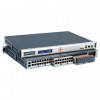Lantronix SLC 8000 Advanced Console Manager User Guide - Page 141
Enable Traps, NMS #1, Trap Version, over TLS, Version, The default is v2c.
 |
View all Lantronix SLC 8000 Advanced Console Manager manuals
Add to My Manuals
Save this manual to your list of manuals |
Page 141 highlights
7: Services Enable Traps Traps are notifications of certain critical events. Disabled by default. This feature is applicable when SNMP is enabled. Traps that the SLC unit sends include: coldStart (generic trap 0, OID 1.3.6.1.6.3.1.1.5.1) linkDown (generic trap 2, OID 1.3.6.1.6.3.1.1.5.3) linkUp (generic trap 3, OID 1.3.6.1.6.3.1.1.5.4 authenticationFailure (generic trap 4, OID 1.3.6.1.6.3.1.1.5.5) slcEventPowerSupply (1.3.6.1.4.1.244.1.1.0.1) slcEventSysadminPassword (1.3.6.1.4.1.244.1.1.0.2) slcEventSLCShutdown (1.3.6.1.4.1.244.1.1.0.3) slcEventDevicePortData (1.3.6.1.4.1.244.1.1.0.4) slcEventDevicePortSLMData (1.3.6.1.4.1.244.1.1.0.5) slcEventDevicePortSLMConfig (1.3.6.1.4.1.244.1.1.0.6) slcEventDevicePortDeviceLowTemp (1.3.6.1.4.1.244.1.1.0.7) slcEventDevicePortDeviceHighTemp (1.3.6.1.4.1.244.1.1.0.8) slcEventDevicePortDeviceLowHumidity (1.3.6.1.4.1.244.1.1.0.9) slcEventDevicePortDeviceHighHumidity (1.3.6.1.4.1.244.1.1.0.10) slcEventDevicePortDeviceError (1.3.6.1.4.1.244.1.1.0.11) slcEventUSBAction (1.3.6.1.4.1.244.1.1.0.14) slcEventInternalTemp (1.3.6.1.4.1.244.1.1.0.13) slcEventDevicePortError (1.3.6.1.4.1.244.1.1.0.15) slcEventSDCardAction (1.3.6.1.4.1.244.1.1.0.16) slcEventNoDialToneAlarm (1.3.6.1.4.1.244.1.1.0.17) slcEventRPMAction (1.3.6.1.4.1.244.1.1.0.18) slcEventPingHostFails (1.3.6.1.4.1.244.1.1.0.19) slcEventDevicePortDeviceContactChanged (1.3.6.1.4.1.244.1.1.0.20) slcEventSFPAction (1.3.6.1.4.1.244.1.1.0.21) slcEventDevicePortAction (1.3.6.1.4.1.244.1.1.0.22) slcEventNetworkFailover (1.3.6.1.4.1.244.1.1.0.23) slcNetworkVPNTunnelAction (1.3.6.1.4.1.244.1.1.0.24) slcEventWireless (1.3.6.1.4.1.244.1.1.0.26) slcEventDHCPServer (1.3.6.1.4.1.244.1.1.0.27) The SLC unit sends the traps to the host identified in the NMS #1 and NMS #2 field using the selected Trap Version. If Enable Traps over TLS is selected, traps will be sent over TLS for v3 traps. For information on these traps, view the SLC enterprise MIB, which is available on the SNMP web page. Note: When the DSR signal drops on a device port, indicating that the attached cable has been disconnected or the attached device has been powered off, the SLC will log the event in the Device Ports system log and send a slcEventDevicePortAction SNMP trap. The log message and SNMP trap only occur if there is an active (connect direct or network connection) to the device port. Trap Version When traps are sent, which SNMP version to use when sending the trap: v1, v2c or v3. The default is v2c. Enable Traps over If selected, the support for outgoing traps and incoming traps using SNMP version 3 TLS over TLS (which uses X.509 certificates for authentication) is enabled, and the default is disabled. You must select Enable TLS to enable traps over TLS, and set the Trap Version to v3. Port Indicates the port number of the traps sent over TLS. It is the port number preceding the Enable TLS port number. For example, if the Enable TLS port is 10161, the Enable Traps over TLS port number will be 10162. NMS #1 (or #2) When SNMP is enabled, an NMS (Network Management System) acts as a central server, requesting and receiving SNMP-type information from any computer using SNMP. The NMS can request information from the SLC 8000 advanced console manager and receive traps from the SLC unit. Enter the IPv4 or IPv6 address of the NMS server. At least NMS #1 is required if you selected Enable Traps. SLC™ 8000 Advanced Console Manager User Guide 141















